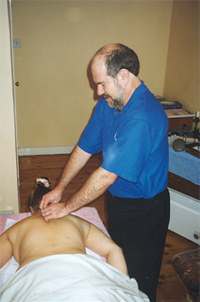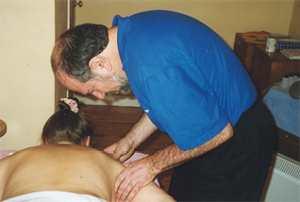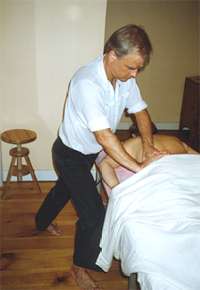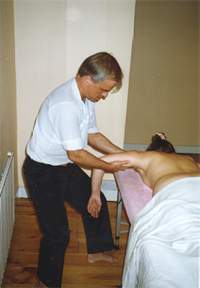Positive Health Online
Your Country

Dynamic Bodyuse in Massage
by Andy Fagg and Darien Pritchard(more info)
listed in massage, originally published in issue 40 - May 1999
Massage is about movement, both within the client but also on the part of the practitioner. Effective movement and bodyuse by the massage therapist can be a key to good treatment, both in terms of physical ease and creating appropriate atmosphere. In this article, we consider the elements, principles and practical ingredients of dynamic bodyuse as well as its benefits.
Evolution of Massage Therapy
Massage, in essence, is a physical activity where the connection between client and practitioner is mediated through touch. Any communication takes place primarily at the level of tissue and physicality. This can lead to a view of massage as the application of standard techniques to physical tissues, in particular skin, muscles and bones, with little scope for feeling or energy. This can also exclude relationship, whether between giver and receiver or self and body.
Such physical approaches include the tradition of routine massages such as are often found in the beauty therapy salon or the sauna rub-down. There is also technically highly proficient massage, employing sophisticated skills, performed by sports therapists and bodyworkers who still see their work as an interventionist or 'fix it' activity. This can become impersonal in intention and execution, approaching the human body in the same way as a mechanic might service a car!
In the last few decades, other elements have lead to the emergence of a more 'holistic' style of massage. Traditions from the East including meditation, T'ai Chi and other martial arts, and bodywork disciplines such as Shiatsu have offered practical ideas of body use closely related to personal development. Also, Western approaches to emotional release have placed greater emphasis on working with the physical body. Common to these is the importance of practitioners continuing to work on themselves in order to embody the energy that they wish to create around their treatment modality.
This synthesis of elements from Eastern and Western approaches to health, leads to a massage therapy that can offer an invitation to let go and allow a reprogramming of somatic patterns, whether they have been induced through physical, emotional or energetic stress. Massage then becomes a process, not a routine. Technical skills and academic knowledge – in particular a thorough understanding of anatomy, physiology and pathology – are vital but within a fundamental dynamic of 'being with' the client rather than 'doing to' them. This creates a space for the client and a sense of presence, which some people describe as having a spiritual basis.
Importance of Bodyuse
Effective bodyuse pulls together many strands of the massage, including quality of touch, awareness of ourselves and the dynamic interchange possible between giver and receiver. There are 3 main aspects to this good bodyuse.
In mechanical terms, we have more effective leverage and pressure available but with the expenditure of less effort. What a relief it is not to have to be as strong as possible! Our hands can soften and strokes come alive through our own movement. We can thus feel, adjust and respond to the nuances of clients' bodies and their reactions. This can allow the massage to become a dialogue of sensation, reaction and response between our hands and our clients' tissues.
Also, good bodyuse enables us to embody within ourselves qualities that we wish to become the atmosphere of the session. Our physical alignment and fluidity and ease of movement are clear indicators of how at home we are within ourselves. We cannot create relaxation for our clients if we are stressing our own bodies in the process! We can foster healthy movement and flow within our clients' bodies modelled upon our own movement and flow at the massage table. This allows us to become a vehicle for whatever energy we believe that we work with. Effective bodyuse also allows us to focus our mental and emotional attention on the massage, expending less effort in 'doing to' our clients and allowing ourselves to 'be with' them far more.
Finally, effective bodyuse offers a valuable means of self-monitoring. As practitioners, we can trust our own bodies to give us feedback, both physical and energetic, when we lose our own centre and grounding. Our own comfort becomes a source of further information both for when we are working well and for when we are off track.
Poor Bodyuse
Two common extremes of poor posture are:

An example of poor posture – standing tall and stiff, no lower body involvement,
massaging from shoulders only. The touch will probably feel invasive and "pokey".
1. Stiff legs, no movement from lower body, massage conducted mainly with shoulders, arms and hands. The hands are often close to the practitioner's body. This approach exaggerates the attitude of 'doing to', is detached, hard, mechanistic and leads to a quality of touch that can feel invasive, 'pokey' and impersonal. The practitioner will become tired quickly and will find it difficult to sustain a full day of treatment sessions.

Over-focused on the client, excessive attention to detail. Will lead to back problems for the practitioner.
2. Another extreme is the posture that crouches over the client with rounded back and excessive attention to detail. This approach can be 'over-caring', smothering and fussy. The quality of touch involved can still feel invasive, but with a sub-text of "please get better because I need you to". This practitioner will also become depleted, probably suffering 'compassion fatigue'.
Both these approaches can lead to many of the common physical strains and difficulties encountered by massage therapists, e.g. lower back pain, hunched shoulders leading to kyphosis, arthritic thumbs and repetitive strain conditions of wrists and forearms. The practitioner may well become disillusioned, cynical or burnt-out.
Good Bodyuse
Good movement is very important. It is possible to adopt apparently good static posture which doesn't then translate into the process of massage at all. So don't just adopt the stance of the photographs! Try the exercises as well! The major ingredients of good bodyuse are as follows:

Weight on front foot and leaning into the stroke. Notice relaxed shoulders and alignment
of body behind hands, from the feet upwards. The touch has both comfort and depth.

Sitting back in the pelvis, allows body weight behind a comfortable stretch.
Again, notice alignment of body behind hands and bent knees.
1. Bending the knees and shifting the weight from foot to foot with a sense of sway, i.e. moving the whole body rather than standing still.
2. Relaxed shoulders, plenty of space between ears and tips of shoulders, so that the main power of the massage comes from the lower body. This can be justified mechanically in terms of the pelvis being the centre of gravity of the body or the most powerful muscle groups in the body being in the thighs, buttocks and abdominal wall. Or, in terms of energy, the belly is the tan-tien (or hara) and is seen in Chinese terms being the centre of the body's chi.
3. Maintaining alignment of hands and trunk whilst moving. This means keeping one's spine soft and long with the hands far enough in front of one's body to allow the transmission of lower body power through them. One exercise is to imagine a spotlight shining from the belly / hara / tan-tien, and then keeping ones hands in the spotlight during a massage.
4. Feet positioning. For long sweeping strokes up and down the body, it is best to keep the feet parallel to the table and the back foot at an angle of 45 degrees.
By aligning the body according to these guidelines, practitioners will be using whole-body energy (chi) rather than just strength and will be centred within themselves, both energetically and mechanically. The quality of touch can be enhanced by good posture and movement. The feeling of it is respectful, caring and able to respond. There is also a clarity, a sense of who I am and who you are and therefore much more ability to give and take whilst maintaining a clear '50/50' contact. Such an approach to massage provides more space for physical and emotional processing to take place. It's also more likely to be energising for practitioners enabling them to perform several sessions within the day. The attitude generated within the treatment room is energising not draining, one that is congruent with an invitation to open and explore oneself through touch.
The dynamic use of body provides important self-monitoring information that practitioners can continue to make use of throughout a series of sessions. For example, noticing which clients one feels uncomfortable with, physically or emotionally, may give some clues on the direction and shape of future treatments. It provides a form of work that offers effective use of physical strength that is both centering and grounding to give and receive. Such effective self-care means that we, as practitioners model for our clients the experience that we are inviting them to step into. It also provides the space for our own growth as practitioners and a framework within which every session is seen as a fresh opportunity for exploration.
There are limits. Sometimes we must adapt our skills according to our physique, our client's physique and particular needs. It would be incongruent to stick rigidly to a particular technique if we have to strain our own bodies in the process. If we can't find a good way to do it then we should just forget it!
Training
We both place great emphasis on dynamic body use during our professional massage training and organise workshops on our Advanced Training Programmes for practitioners from other schools to extend and develop their work in this way. Perhaps as standards of massage training continue to improve in this country, such courses currently available only as post-graduate training will become standard within all certificated training.
This approach to bodywork is an important feature of the Massage Training Institute (MTI), of which we are Directors. The MTI is a member of the British Massage Therapy Council, all of whose member bodies offer courses of at least nine months duration, with a minimum of 150 class hours and a core syllabus with clear and improved standards of anatomy, physiology and pathology. Although (see Leon Chaitow's article in issue 36) these standards are nowhere near those available in the USA or Canada, they represent a substantial improvement within the UK and are an important concerted effort to improve the quality of massage therapy in this country.
|
Exercises for Bodyuse 1. Aligning bodyweight behind hands 2. Hara Spotlight 3. Imagery and Movement |
Comments:
-
No Article Comments available